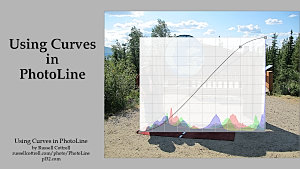 New in 2022, watch the YouTube video series starting with
Using Curves in PhotoLine:
New in 2022, watch the YouTube video series starting with
Using Curves in PhotoLine:2. layer masks
3. saturation and vibrance curves
4. color filters, blend modes, and color balance
5. Lab curves
An Introduction to Photo Editing with PhotoLine
Welcome to PhotoLine! This tutorial is designed both for people who are coming to PhotoLine from another image editing application, as well as for people who are new to photo editing and for whom PhotoLine is their first application. It is intended to be a “walk-through” of the main tasks associated with photo editing rather than a comprehensive reference.
Part of the need for such a tutorial is that little has been written along these lines so far. And much of the information available appears to be oriented toward graphic arts production. Which is fine; but my own interest is photographic image editing. Another motivation is that PhotoLine has developed a reputation for being harder to use than some other applications. This has happened partly because the tools and menus are in fact different in places from other widely-used applications, and people who switch to Photoline may have some initial trouble unlearning their old habits. In this respect, PhotoLine is not more difficult per se, just different. Hence this tutorial, to demystify the major procedures at least. And, the default user interface is not what I would consider the best; but fortunately it is fully customizable, and I have provided an alternate layout which is explained on the next page. An endearing feature used to be occasional German menu items; I believe that they have all been fixed.
So why use PhotoLine? Several big reasons: besides having everything one expects from an image editor, such as 16 and 32-bit channels, CMYK and Lab editing, and full color management, it has advanced features like layer-specific image modes (an Lab layer within an RGB image, for example), hue and saturation curves, and adjustment layers for adjustment layers; it works perfectly in Linux using Wine; it runs plugins compatible with similar applications; and last but not least, for 59 Euros it comes with a permanent license; no subscription is necessary.
PhotoLine can actually be thought of as several programs in one: a photographic image editor, a vector graphics editor, a desktop publisher, a raw processor, and an image browser. This tutorial concerns the former, with a page devoted to raw processing, and forays into vector graphics and text editing on the scripting page.
For more information, read about its features and what’s new. This tutorial was originally created with version 20.02 for Windows, 64-bit, and includes updates for version 21.50. (There are minor layout differences between the Windows and Macintosh versions.)
 New in 2022, watch the YouTube video series starting with
Using Curves in PhotoLine:
New in 2022, watch the YouTube video series starting with
Using Curves in PhotoLine:Site © 2022 by Russell Cottrell; license is personal use, free distribution.
PhotoLine is a registered trademark of Computerinsel (“Computer Island”) GmbH, Bad Gögging, Germany. This site is not affiliated with Computerinsel.
| Table of contents: | |
|
Setup Download and install Layout ICC color profiles Color Management Plugins Basic Concepts Document vs. picture Layers Adjustment layers Layer masks Color filters Color vs. luminance Bit depth Assigning/Setting/Tagging vs. Converting Color Profiles Opening an image Saving an image Undoing actions The Toolbox Luminance Curves Layer Masks RGB Curves Hue/Saturation Hue/Saturation layers Saturation curves Color filters Lab curves Actions Resizing, Cropping, Sharpening, Spotting Resizing Cropping General sharpening concepts Sharpening with PhotoLine Spotting/Retouching Raw Conversion The Placeholder/Background layer Sensor array interpolation/demosaicing The Lens Correction layer Lensfun Perspective and vignetting Chromatic aberration The Vector layer Correct Highlights (Raw white points) The Raw Adjustments layer Histogram correction Curves, Light/Shadow Color temperature Noise reduction Sharpening Notes on raw conversion using .icc profiles |
Advanced Selections and Masks Selecting, copying, pasting Color filters Channel selections Child adjustment layers Black/White Conversion, Channel Mixing, and Toning The easy ways The old-fashioned Channel Mixer The newfangled Gray Mixer Colorize Miscellaneous concepts HDR Imaging Miscellaneous Adjustments and Techniques Dehaze Light/Shadow and Exposure Shadows/Highlights Contrast Masking Luminosity Masks and Color Filters Printing Printer profiles Display profile Resize and sharpen Proof mode Output Levels Printer profile and print options Placeholders Scripting The script libraries Sample scripts Custom dialogs Scripted actions Tips and Tricks Bibliography Gallery |
12048
Get started: setup